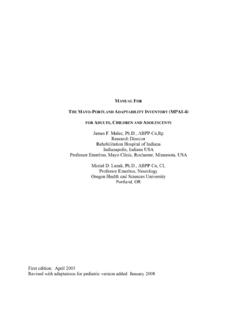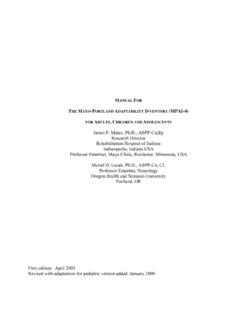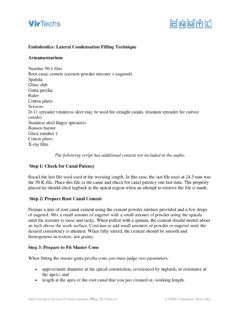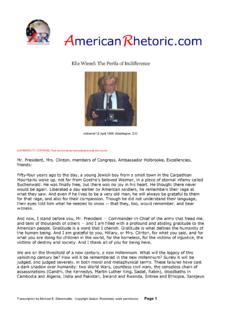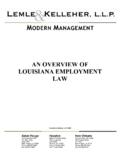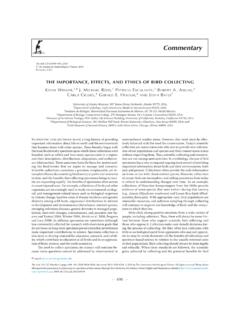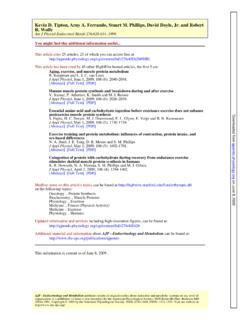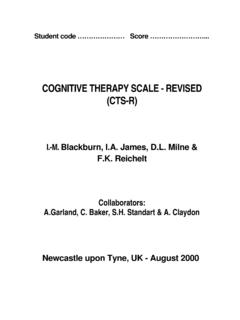Transcription of COMA RECOVERY SCALE-REVISED - tbims.org
1 CRS-R COMA RECOVERY SCALE-REVISED 2004 Administration and Scoring Guidelines Joseph T. Giacino, and Kathleen Kalmar, Center for Head Injuries Edison, New Jersey Johnson Rehabilitation Institution Affiliated with JFK Medical Center Updated 11-1-05 Record FormADM2345678910111213141516 AUDITORY FUNCTION SCALE4 - Consistent Movement to Command *3 - Reproducible Movement to Command *2 - Localization to Sound1 - Auditory Startle0 - NoneVISUAL FUNCTION SCALE5 - Object Recognition *4 - Object Localization: Reaching *3 - Visual Pursuit *2 - Fixation *1 - Visual Startle0 - NoneMOTOR FUNCTION SCALE6 - Functional Object Use t5 - Automatic Motor Response *4 - Object Manipulation *3 - Localization to Noxious Stimulation *2 - Flexion Withdrawal1 - Abnormal Posturing0 - None/FlaccidOROMOTOR/VERBAL FUNCTION SCALE3 - Intelligible Verbalization *2 - Vocalization/Oral Movement1 - Oral Reflexive Movement0 - NoneCOMMUNICATION SCALE2 - Functional: Accurate t 1 - Non-Functional: Intentional *0 - NoneAROUSAL SCALE3 - Attention 2 - Eye Opening w/o Stimulation1 - Eye Opening with Stimulation0 - UnarousableTOTAL SCORED enotes emergence from MCS tDenotes MCS *WeekPatient:Date of Onset.
2 JFK COMA RECOVERY scale - REVISED 2004 This form should only be used in association with the "CRS-R ADMINISTRATION AND SCORING GUIDELINES" which provide instructions for standardized administration of the of Admission:Diagnosis:Etiology:1 Record FormPatient:Date:ReactiveEqualConstricte dDilatedPinpointAccommodationAbsentPrese nt UnilateralPresent BilateralNoneSkew DeviationConjugate Gaze DeviationRovingDysconjugateNoneAbnormalF ullNormalAbnormal ExtensionAbnormal FlexionBRAIN STEM REFLEX GRID 2004 Pupillary LightCorneal ReflexSpontaneous Eye MovementsNOTESO culocephalic ReflexPostural Responses (Indicate Limb)21)2)3)1)2) - Sustained eye closure re-occurs OR AROUSAL FACILITATION PROTOCOL 2004 - Exhibit sustained eyelid closure AND/OR - Stops following commands for a period of at least one the arousal facilitation protocol when:GUIDELINESThe goal of this intervention is to prolong the length of time the patient maintains arousal ( eye opening)The protocol is administered anytime the patient is observed to: - Behavioral responsiveness ceases despite sustained eye Pressure:Administer same on contralateral deep pressure stimulation unilaterally to the face, neck, shoulder, arm, hand, chest, back, leg, foot, and toes.
3 The muscle should be firmly grasped at its base between the thumb and forefinger. While squeezing the muscle firmly, it should be "rolled" back and forth through the finger tips three to four times. This procedure should be repeated sequentially working from the facial musculature to the toes. The examiner should assure that there are no internal lines, local injuries ( , fractures, contusions, decubiti) or systemic complications ( , heterotopic ossification) before administering deep pressure. 3 ScoreItemMethodResponse1. Observe frequency of spontaneous movement for a one minute interval (See Baseline Observation and Command Following Protocolon page 5). Clearly discernible and accurate responses occur within 10 seconds on all 4 trials Choose at least 1 object-related and 1 non-object related command from the Command Following Protocol. The type of command chosen (eye, limb, oral) should be based on patient's physical capacity and should be of low spontaneous frequency.
4 If time permits, more than one type of command from each category may be used. The command should be repeated onceduring the 10 second response interval. This item is credited only when all 4 trials of 2 different commands are Movement to Commanda. Object-Related Eye Movement Commands: Present 2 common objects simultaneously and approximately 16 inches apart within the patient's field of view. Ask the patient to look at the object named ( "Look at the [name object]". Next, reverse the positions of the 2 objects and ask the patient to look at the same object again ( "Look at the [name object]"). Administertwo additional trials using the same 2 objects and repeat the above procedure with instruction to look at the other object on both trials. Two trials per object should be administered for a total of 4 Object-Related Limb Movement Command: Present 2 common objects simultaneously and approximately 16 inches apart within the patient's field of view and within arm's (or leg's) length and ask the patient to touch the object named with their hand (or foot).)
5 Next, reverse the positions of the 2 objects and ask the patient to touch the same object again. Administer two additional trials using the same two objects and repeat the above procedure with instruction to touch the other object on both trials. Two trials per object should be administered for a total of 4 trials. c. Non-Object Related Commands: Select at least 1 eye movement, limb movement or oral movement/vocalization command and present it over 4 trials at 15 second intervals. The same command should be used for all 4 trials. Movements that occur between commands (ie: after the response interval has elapsed) should be noted but not scored. 3 Reproducible Movement to CommandSame as above3 clearly discernible responses occur over the 4 trials on any one of the object or non-object related FUNCTION scale 2004 4 AUDITORY FUNCTION scale 2004 ScoreItemMethodResponse2 Localization to SoundStanding behind the patient and out of view, present an auditory stimulus (eg.)
6 Voice, noise) from the right side for 5 seconds. Perform a second trial presenting the auditory stimulus from the left side. Repeat above procedure for a total of 4 trials, 2 on each and/or eyes orient toward the location of the stimulus on both trials in at least one direction. This item is scored when there is clear evidence of head and/or eye movement. It is not dependent on the degree or duration of StartlePresent a loud noise directly above the patient's head and out of view. Administer 4 flutter or blink occurs immediately following the stimulus on at least 2 aboveNo response to any of the above5 BASELINE OBSERVATION AND COMMAND FOLLOWING PROTOCOL 2004 CommandsBaselineTrial 1 Trial 2 Trial 3 Trial 41 minute frequency countI Object Related CommandsA. Eye Movement CommandsLook at the (object #1)Look at the (object #2)B. Limb Movement CommandsTake the (name object #1)Take the (name object #2)Kick the (name object #1)Kick the (name object #2)II Non-Object Related CommandsA.
7 Eye Movement CommandsLook away from meLook up (at ceiling)Look down (at floor)B. Limb Movement CommandsTouch my handTouch your noseMove your (object/body part)C. Oral Movement/Vocalization CommandsStick out your tongueOpen your mouthClose your mouthSay "ah"Spontaneous Eye OpeningYes:No:Spontaneous Visual TrackingYes:No:Resting PostureRUE:RLE:LUE:LLE:6 VISUAL FUNCTION scale 2004 ItemMethodResponse5 Object RecognitionSame as Consistent Movement to Command on Auditory Function scale , Section 2a and b (p. 3).3 to 4 clearly discernible responses occur over the 4 trials Identify the arm or leg with the greatest range of movement. Score the direction in which the limb first moves within a 10 second observation period, or score as2. For upper extremity reaching, select common ADL objects ( comb, toothbrush, etc.). For lower extremity assessment, select a ball suitable for kicking. no movement.
8 The limb does not need to make contact with the object, only to move toward it;and4 Object Localization: Reaching3. Present the object approximately 8 inches to the left or right of the limb's resting position. The object should be placed in a position that is not obstructed from view. The patient should be instructed to "Touch the (name object)" with the appropriate arm or must occur in the correct direction on 3 of the 4 trials administered. 4. The command may be repeated once within the assessment interval. Do not provide any tactile cues, as these may stimulate random limb Present an object twice to the left of the limb and twice to the right of the limb, in random order for a total of 4 a hand mirror 4-6 inches directly in front of the patient's face and verbally encourage the patient to fixate on the must follow the mirror for 45 degrees without loss of fixation on 2 occasions in any PursuitMove mirror slowly 45 degrees to the right and left of the vertical midline and 45 degrees above and below the horizontal above criterion is not met, repeat the procedure assessing one eye at a time (using an eye patch).
9 Repeat the above procedure so that a total of 2 trials are administered in each a brightly colored or illuminated object 6 to 8 inches in front of the patient's face and then rapidly move to upper, lower, right and left visual fields for a total of 4 change from initial fixation poinand refixate on the new target location for more than 2 seconds. At least 2 episodes of fixation are StartlePresent visual threat by passing finger 1 inch in front of patient'seye. Be careful not to touch eyelashes or create a breeze (manually open eyes if necessary). Conduct 4 trials per flutter or blink following presentation of visual threat on at least 2 trials with either aboveNo response to any of the FUNCTION scale 2004 ItemMethodResponse6 Functional Object UseSelect 2 common objects ( comb, cup). Place one of the objects in the patient's hand and instruct the patient to "Show me how to use a [name object].
10 " Next, place the second object in the patient's hand and restate the same instruction. Movements executed are generally compatible with both object's specific function ( comb is placed on or near the head) on all 4 trials administered. Repeat the above procedure using the same objects so that a total of 2 trials are administered with each object. If the patient is unable to hold the object because of neuromuscular involvement, this should be noted on the record form and the item should not be for automatic motor behaviors such as nose scratching, grasping bedrail that occur spontaneously during the least 2 episodes of automatic motor behavior are observed within the session and each episode can be clearly differentiated from a reflexive spontaneous automatic motor behaviors are not observed, present a familiar gesture ( wave) in association with the following series of alternating commands: Patient performs the gesture ( waves) on trials 2 and 4(regardless of performance on trials 1 and3).


